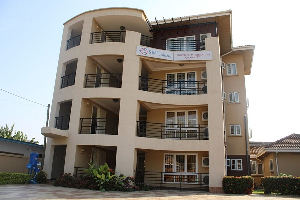Business News of Monday, 21 July 2008
Source: --
BOG raises interest rate

Accra, July 21, GNA - The Monetary Policy Committee on Monday announced a one per cent increase in the prime rate, the reference interest rate used by banks, citing fears of high inflation expectations.
The rate has gone up to 17 per cent from 16 per cent.
"The current rise in inflation has pushed up the disinflation path further from the target in the horizon, and monetary policy needs to be vigilant to avoid a build-up in inflation expectations," Dr Paul Acquah, Chairman of the MPC, told a press conference after a meeting of the Committee.
Inflation has consistently risen from 13.8 per cent in March to 18.4 per cent as at the end of June, buoyed by high food and crude oil prices.
Dr. Acquah, who is also the Governor of the Bank of Ghana, said the uncertainty about developments in crude oil prices, the rise in inflation and a surge in food prices had softened business and consumer confidence.
Analysts say the increase in the prime rate is likely to aggravate the situation since it will translate into a further upward review of the lending rates by commercial banks.
However, Dr Acquah said, there was still high optimism about general economic prospects.
He maintained that the economy had continued its growth momentum on account of strong demand growth driven by exports and increased spending.
Total merchandised exports for the first half of the year amounted to 2.8 billion dollars compared to 2.1 billion dollars for the same period in 2007.
Cocoa beans and products, gold and non-traditional exports led a good rally of export products with strong performance in the first half of the year.
"The banking system remains liquid and is building diversified portfolios funded by increased deposits with some tightening in credit conditions. And the prospects are for continued growth at a robust pace," Dr Acquah said.
Credit to the private sector alone rose by GH¢1,206.9 million (or 50.3 per cent), compared with GH¢776.5 million (47.8 per cent) during same period in 2007.
Distribution of the annual credit flow was fairly broad-based as all sectors recorded some increases in credit over the period. The services sector accounted for 42.4 per cent, construction (10.7 per cent), manufacturing (8.5 per cent), commerce and finance (6.8 per cent) and transportation, storage and communication (5.0 per cent). The remaining sectors recorded modest increases of between 0.9 per cent and 2.7 per cent.
Dr Acquah said the latest credit conditions survey revealed that net demand for credit was principally driven by small and medium size enterprises.
Banks continued to increase access to credit for households with some shortening of maturities, but there was a net tightening of credit conditions for enterprises and the mortgage sector. On the overall balance of payments position, Dr Acquah said the country recorded a deficit of US$782.7 million in the first half of 2008.
This was due mainly to the rising crude oil prices. Oil imports for the period amounted to US$1,257.0 million (25.4 per cent of total imports) compared with US$846.6 million (24.4 per cent of total imports) for the same period in 2007.
Total merchandised exports for the first half of 2008 amounted to US$2,885.4 million, compared with US$2,142.8 million (a growth of 34.7 per cent) for the same period in 2007.
The Gross International Reserves (GIR) at the end of June 2008 was US$2.3 billion, and translates on average into goods and services import cover of 2.4 months
PRESS RELEASE OF THE MONETARY POLICY COMMITTE - 21-07-08
1. Good Morning Ladies and Gentlemen. Let me welcome you to this meeting.
2. As you are no doubt aware, the current global environment is characterized by fears of rising inflation in both emerging and industrialized countries, accompanied in many cases by possible significant slowdown in economic activity and rising unemployment. There also continues to be uncertainty about crude oil and food prices; and the credit crunch and turmoil in the financial market continues to unfold.
3. Domestically, there have been quite rapid price increases and some volatility on the foreign exchange market. The latest survey suggest that uncertainty about developments in crude oil prices, the rise in inflation, and a surge in food prices have further softened business and consumer confidence in the short run, but optimism remains high about general economic prospects.
4. On the economy, latest information continue to show sustained pace in economic activity. The Bank’s Composite Index of Economic Activity (CIEA) continued to show a strong growth into the second quarter of 2008. The index at the end of May 2008 rose by 4.4 percent over the level recorded for the first quarter, and 22.9 percent in year-on-year terms, which was above the trend growth rate of 21.3 percent. This compares with 21.5 percent recorded in the same period of 2007. Increases in the overall index were broad based and reflected in all the major sub-components.
5. Evidence from other real sector indicators also point to sustained momentum in economic activity. Cement production for the first five months of the year (January to May 2008) amounted to 1,044,859 metric tons, a growth of 20.5 percent over the level of 867,165 metric tons for the same period in 2007. Similarly, benchmark retail sales recorded a growth of 35.9 percent compared with sales for the same period in 2007: And a total of 47,271 motor vehicles were registered within the first five months to May 2008, compared with 36,040 for the same period in 2007 (a growth of 31.2 percent). Labour market statistics showed relatively strong demand for labour during the first half of the year. Cumulatively for the period January to June 2008, a total of 5,788 jobs were advertised, compared with 3,541 for the same period in 2007.
6. Financial data released by listed companies for the period ended June 2008 showed significant growth in turnover and profits in the corporate sector including Manufacturing, Agriculture, Insurance and Food & Beverages sectors, except for Distribution, Information Technology and Oil Marketing where profits dipped.
7. Credit to the private sector and public institutions continued to be strong in the second quarter of 2008. For the twelve month period to May 2008, credit to the private sector and public institutions rose by GH¢1,699.9 million (58.0 percent) on top of the GH¢858.1 million (41.4 percent) recorded for the same period in 2007.
• Credit to the private sector alone rose by GH¢1,206.9 million (or 50.3 percent), compared with GH¢776.5 million (47.8 percent) during same period in 2007.
• Distribution of the annual credit flow was fairly broad-based as all sectors recorded some increases in credit over the period. The services sector accounted for 42.4 percent, miscellaneous (13.3 percent), construction (10.7 percent), manufacturing (8.5 percent), commerce and finance (6.8 percent), and transportation, storage and communication (5.0 percent). The remaining sectors recorded modest increases of between 0.9 percent and 2.7 percent.
• Distribution of credit flow by user showed increasing significance of households in the loan portfolio of banks. The share of households in the total increase in credit over the 12-month period to May 2008 rose to 33.4 percent, up from 19.2 percent for the same period in 2007, while Enterprises shared 66.0 percent (down from 77.7 percent in 2007). On year on year basis, credit to households increased by 89 percent to GH¢856.3 million, compared with 49 percent increase for the same period in 2007.
8. The latest credit conditions survey revealed that net demand for credit was principally driven by small and medium sized enterprises. Banks continued to increase access to credit for households with some shortening of maturities, but there was a net tightening of credit conditions for enterprises and the mortgage sector.
9. Developments in the banking system through May 2008 show continued strong asset growth. Total assets of the banking industry stood at GH¢8,437.7 million in May 2008, 4.4 percent growth over the level at the end of March 2008, and an annual growth of 37.1 percent, compared with 45.7 percent for May 2007 (GH¢6,156.6 million). In a clear shift from investments in financial assets to lending to the private sector, the proportion of assets invested in government securities and other debt instruments by banks declined from 15.6 percent in May 2007 to 1.6 percent in May 2008, since the secondary reserve requirements was abolished.
10. The growth in assets was mainly funded by deposits which amounted to GH¢5,499.4 million, a growth of 3.3 percent over the level recorded in March 2008, representing an annual growth of 38.5 percent. Savings & Time deposits grew by 37.0 percent to GH¢2,004.9 million in the twelve month period to May 2008, compared with GH¢1,463.0 million (54.5 percent) for the same period in 2007. Foreign currency deposits also increased by 33.2 percent to the equivalent of GH¢1,273.9 million in the twelve month period to May 2008, compared with GH¢955.3 million (32.9 percent) for the same period in 2007.
11. The quality of the banking industry’s loan portfolio remained generally strong. Non-Performing Loans (NPL) which stood at 8.7 percent at the end of March 2008 inched up to 8.8 percent at the end of May 2008. Loan loss provision to gross loans ratio, however, edged down from 6.6 percent to 6.3 percent over the same period. Banks’ solvency remained very strong at 14.2 percent in May 2008, compared with 14.9 percent for 2007. All the banks maintained a Capital Adequacy Ratio (CAR) above the statutory required minimum.
12. Provisional data available show an estimated broad money (M2+) growth of 3.9 percent in the second quarter of 2008, compared with a growth of 3.3 percent in the first quarter. For the same periods in 2007, M2+ grew by 5.7 percent and 1.2 percent respectively. Annual M2+ growth in May 2008 was 36.1 per cent, down from 37.7 per cent recorded for the same period in 2007 and 36.3 per cent at the end of 2007.
13. As regards developments in public finances, provisional banking data for the first half of 2008 show that total revenue and grants amounted to GH¢2,201.2 million (13.5 percent of GDP) compared with GH¢2,085.4 million (14.9 percent of GDP) for the corresponding period in 2007. This outturn represents an annual growth of 5.6 percent compared with 38.2 percent for the same period in 2007.
14. Total expenditure (excluding capital expenditure externally financed by Development Partners) amounted to GH¢2,803.5 million (17.2 percent of GDP) including GH¢304.8 million financed from Sovereign Bond proceeds, compared with GH¢2,331.6 million (16.7 percent of GDP) for the same period in 2007. This represents a year-on-year expenditure growth of 20.8 percent, compared with 50.7 percent for the same period in 2007.
15. Overall the preliminary data show a narrow budget deficit of GH¢622.9 million (3.8 percent of GDP) for the half year compared with GH¢285.2 million (2.0 percent of GDP) for the same period in 2007. The deficit, was mainly financed to the tune of GH¢392.5 million (2.4 percent of GDP) domestically, and withdrawals from the sovereign bond account of GH¢304.8 million (1.9 percent of GDP).
16. The stock of domestic debt (gross) which stood at GH¢3,708.2 million (26.5 percent of GDP) at the end of 2007 increased to GH¢4,005.9 million (24.6 percent of GDP) at the end of the first half of 2008. And, the stock of external debt at the end of 2007 increased from US$3,590.4 million (24.9 percent of GDP) to US$3,809.3 million (24.1 percent of GDP). This brings total public debt stock to 48.7 percent of GDP by the end of June 2008.
17. Generally there has been significant re-alignment of interest rates on the money market and shifts in portfolio preferences from the long dated instruments to the shorter end of the market, in line with the rise in consumer price inflation.
• Overnight interbank rates firmed-up by 244 basis points from March to 14.48 percent at the end of June 2008.
• The benchmark 91-day Treasury Bill rate has increased cumulatively by 570 basis points over the first half of the year to 16.32 percent at the end of June 2008 with an increase of 522 basis points in the second quarter.
• The 182-day Treasury Bill rate similarly firmed-up by 86 basis points and 547 basis points in the first and second quarters of 2008 respectively to 17.13 percent in June 2008.
• The 1-year-note and the 2-year fixed rate note similarly moved up by 420 basis points and 370 basis points respectively to 16.5 percent each. The rate on the 3-year fixed bond rose to 16.0 percent from 14 percent over the same period.
• Average base rate quotations of the banks were revised upward by 258 basis points to 22.26 percent in June 2008 after a 92 basis points increase in the first quarter of 2008. Average lending rates were similarly revised upward marginally by 63 basis points to 24.79 percent in the second quarter within the range 15.0 – 34.58 percent, and the spread over the benchmark 91-day Treasury Bill rate fell by 508 basis points.
• Average interbank money market rates moved up by 199 basis points during the second quarter to 14.48 percent in June 2008, after moving up by 45 basis points in the first quarter of the year. The rates were in close alignment with the Bank of Ghana Prime Rate.
18. On the external front, the average price of cocoa beans exports increased by 4.8 percent to US$2,196.05 per tonne at the end of June 2008 from US$2,095.09 per tonne at the end of March 2008. Average export price of Gold on the other hand, declined from US$916.64 per ounce at the end of March 2008 to US$892.33 at the end of June 2008.
19. The average weekly price per barrel of the benchmark Brent crude oil closed June at US$139.73, representing 35.5 percent increase over the end March 2008 level, and about 96.3 percent increase in year-on-year terms. The price of crude oil was US$136.36 per barrel as at July 18, 2008.
20. Total merchandised exports for the first half of 2008 amounted to US$2,885.4 million, compared with US$2,142.8 million (a growth of 34.7 percent) for the same period in 2007.
• Exports of cocoa beans and products amounted to US$934.2 million, compared with US$742.3 million for the same period in 2007 (an annual growth of 34.6 percent). Cumulative cocoa purchases for the 2007/2008 season through the end of June totalled 646,144 tonnes, against a forecast of 636,000 tonnes for the entire crop season.
• Gold exports for the first half amounted to US$1,188.3 million compared with US$821.0 million for the same period in 2007.
• Non-traditional exports for the first half of the year amounted to US$631.1 million, compared with US$458.4 million for the same period in 2007.
21. Total merchandise imports for the period January to June 2008 amounted to US$4,945.6 million, compared with US$3,473.6 million for the same period in 2007 (an annual growth of 42.4 percent).
• Oil imports for the period amounted to US$1,257.0 million (25.4 percent of total imports) compared with US$846.6 million (24.4 percent of total imports) for the same period in 2007.
• Non-oil imports amounted to US$3,688.5 million for the first half of the year (74.6 percent of total imports), compared with US$2,626.9 million for the same period in 2007. Capital and intermediate goods together accounted for 74.8 percent of total imports compared with 76.9 percent for 2007.
22. For the half year of 2008, the merchandise trade deficit is provisionally estimated at US$2,060.2 million, compared with a deficit of US$1,330.7 million for the same period in 2007. The current account is provisionally estimated to have recorded a deficit of US$1,171.3 million (in part due to an increase of US$411.0 million in the oil import bill), compared with a deficit of US$639.8 million for the same period in 2007.
23. The overall balance of payments position recorded a deficit of US$782.7 million in the first half of 2008, following a strong build-up of reserves of US$980.0 million in the fourth quarter of 2007, partly from Sovereign Bond proceeds. The deficit compares with US$124.3 million in 2007.
24. Gross International Reserves (GIR) at the end of June 2008 was US$2.3 billion, and translates on average into goods and services import cover of 2.4 months.
25. The foreign exchange market saw increased activity over the first half of 2008. Total purchases and sales in the foreign exchange market by banks and forex bureaux amounted to US$5.2 billion for the first half of the year, 17 percent higher than US$4.4 billion for the same period in 2007.
26. Private inward transfers – received by NGOs, embassies, service providers, individuals etc. - through the banks and finance companies for the first half of the year amounted to US$4.2 billion, which represents 30.9 percent increase over the amount of US$3.2 billion recorded for the corresponding period in 2007.
• Of the total transfers for the period January to June 2008, US$798.9 million (or 19.1 percent) accrued to individuals, compared with US$718.1 million (22.7 percent) for the same period in 2007.
27. There was some increased volatility in the foreign exchange market during the first half of 2008, with large movements in major currencies, and sharp appreciation of the Euro seen on the international market. The cedi depreciated against all the three major currencies – the US dollar, the Pound Sterling, and the Euro - during January to June 2008 by 6.4, 5.7, and 12.4 percent respectively. This compares with relatively lower depreciations of 0.6, 2.7, and 2.8 percent respectively recorded for the same period in 2007. The cedi depreciated in trade weighted terms by 4.9 percent over the period, compared with 1.7 percent for the same period in 2007.
Inflation and Outlook
28. The latest consumer price inflation numbers released by the Ghana Statistical Service (GSS) show that overall inflation which stood at 13.8 at the end March, increased to 18.4 percent at the end of June 2008. Sub components which recorded significant jumps in inflation were Housing and Utilities (made up of rental charges for housing, water, electricity, gas for cooking, kerosene) which increased from 12.9 percent in June 2007, to 22.6 percent in December 2007, and slowed down slightly to 19.1 percent in June 2008. Similarly, transport sector (which includes petrol and diesel oil) increased from 20.8 percent in June 2007, to 21.5 percent in December 2007, and further to 29.1 percent in June 2008. Food inflation increased by 4.8 percentage points to 17.7 percent while non-food inflation increased by 4.5 percentage points to 18.9 percent during the quarter ended June 2008.
29. Core inflation (defined to exclude energy and utility) continued to increase as these price pressures filter into underlying inflation. Core inflation increased further to 12.8 percent in June 2008 from 10.2 percent in March; and was 9.4 percent at the beginning of the year.
30. Growth momentum in the economy has been sustained with activity proceeding above trend, and with strong demand growth driven by exports, and increased fiscal stimulus. The banking system remains liquid, and is building diversified portfolios funded by increased deposits with some tightening in credit conditions. And, the prospect is for continued growth at a robust pace.
31. The risk in the outlook for inflation is on the upside given the uncertainties associated with oil prices. The current rise in inflation has pushed up the disinflation path further from the target in the horizon, and monetary policy needs to be vigilant to avoid a build-up in inflation expectations.
32. In the circumstances, the Monetary Policy Committee (MPC) has decided to increase the Prime Rate from 16.0 percent to 17.0 percent.
Thank you for your attention.
News

Canada-based Ghanaian woman wins heart of disguised rich 'beggar' after she offered him free pie
Sports

Thomas Partey, Inaki Williams set for Black Stars return after missing Nigeria, Uganda friendlies
Entertainment

Mahama assigned security protection to me and Oppong Nkrumah when we were criticizing him - A Plus
Opinions



